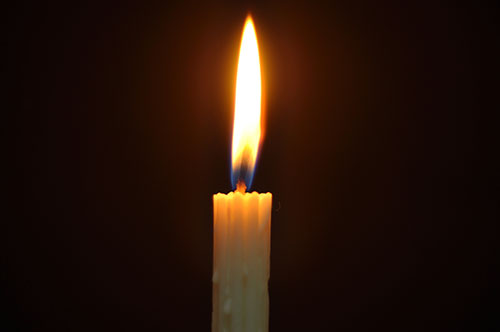
New research looks at the distance from which a candle flame can be seen. (Shutterstock/underverse)
By Andrew Silver
Can the unaided eye see the light from a single candle from 10 miles away? According to some claims on the Internet, the answer is yes – but now two scientists in the US have borrowed techniques from astronomy to show that a pair of binoculars would probably be needed.
The story behind this work began high in the Andes one moonless night when a candle was lit on the Cerro Tololo Inter-American Observatory telescope catwalk. Somebody walked 400–600 m away and said the flame was as bright as the brightest stars in the sky. Nobody wrote down any numbers.
Kevin Krisciunas, an astronomer at Texas A&M University, heard about the experiment and tried it in the suburbs. There was too much light pollution, so he thought about using the Texas A&M Observatory.
Don Carona, the director, instead offered a CCD camera to help measure the brightness of a flame against a highly visible magnitude zero star, Vega. The duo came up with a rule to describe the brightness relationship, adapting it to compare a candle flame to the faintest star an average unaided human eye can see: a magnitude-six star.
Carona and Krisciunas then turned their attention back to candle spotting. Various sources on the Internet suggest that a candle is visible to the unaided eye at distances varying from 3.6 to 30 miles. Such claims might come from 1940s work out of Columbia University that looked at how the eye responds to flashes of light in a dark room. This is a different question, says Krisciunas, who adds that watching a candle flicker isn’t the same as observing flashes of light.
By comparing the candle flame to a magnitude-six star, the researchers discovered that you would need 7 × 50 binoculars to see a candle 10 miles away. Furthermore, the farthest from which an average unaided human could see a candle is about 1.6 miles.
“It’s a pretty good estimate,” says UC Davis astronomer Maruša Bradač, who was not involved in the work.
However, this distance assumes sky observation and the atmosphere thins out as altitude increases allowing more light to pass through it. A ground based observation would have to contend with a thicker atmosphere so 1.6 miles is probably an overestimate.
A distance of 1.6 miles could be tested, although it would be difficult. So if any physicsworld.com readers can find somewhere with a clear horizontal line of sight of 1.6 miles, perhaps they could light a candle, back up and watch. And of course, share their results here by leaving a comment.
Carona and Krisciunas report their findings in a preprint on the arXiv server: “At what distance can the human eye detect a candle flame?”.
It seems that the eye is able to see one photon of the visible spectrum of the candle. Hence, under the given atmospheric conditions, one has to find the range (mean distance) that leaves one photon at the end for the candle.
This is a part of my view.
I say Gravity affects light
In my opinion,
If there is a long horizontal surface we are able to see everything in a long distance even and especially in space.
I say if you see that light from 1.6 miles away and now we look at the light of candle vertically so we see it from 5.2 mile .
I can prove it
Who is M. Asghar and why is (s)he so keen to set the first comment on each article? M. Asghar: Reveal yourself!
An interesting discussion. I have read years ago of WWI pilots at an altitude of 5000 feet (say a mile or so) having seen a cigarette being lit on a dark night under good conditions. That is about equivalent to a candle at a mile, even if the precision was pretty low.
And of course, smokers were notoriously tempting targets for night-time snipers. (So were their neighbours; that is how Saki died!)
I agree however, that detecting a few photons is not the same as “seeing a candle” under uncontrolled conditions, either with or without binoculars. Having had some experience with binoculars at night though, especially with large objective lenses, I confirm that one can see surprising improvements in detail as well as sensitivity in conditions of subjectively deep darkness.
Last autumn I and a colleague tried to replicate the Paul Revere latern signalling(one by land, two by sea) in a dark corn field in Western Massachusetts. We used two replica candle lanterns and varied both the distance among the lanterns and to us. With the two lanterns approx. four feet apart we could easily see and distinguish them at half a mile distance, just about at three quarter of a mile, and struggled to see the flames at a mile distance. We concluded that the light signalling across Charles River would have been possible but that the observers probably would have been younger than us and used a portable telescope.